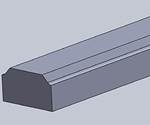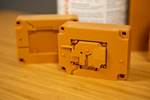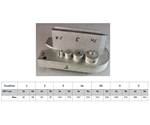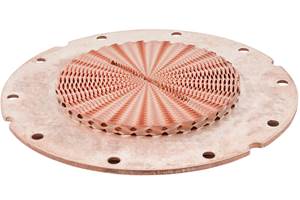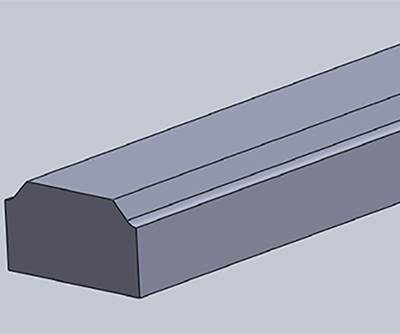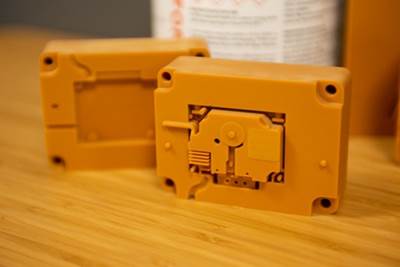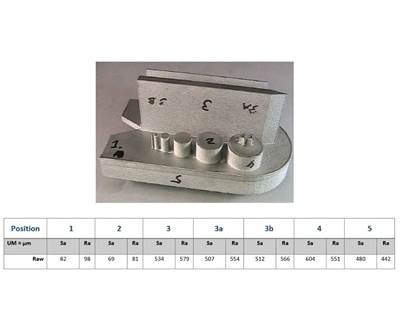Production additive manufacturing (AM) almost always involves some level of postprocessing — that is, some amount of cleaning, curing, heat treating, machining, dyeing or other procedure that happens after the form of the part is built up through 3D printing. But finishing (here, the application of coatings, plating and other surface improvements) of 3D printed parts is not necessarily widespread or well understood as of yet.
Part of the reason may be AM’s slow advance into the kinds of high-volume production applications that tend to occupy finishers today; as quantities increase, however, 3D printed parts will find their ways into more and more places where electroplating, powder coating, anodizing and similar processes are needed. New opportunities will arise where 3D printing can provide the geometric form but finishing can bring the needed conductivity, wear resistance or other properties to a component.
I discussed the potential opportunities and challenges involved with applying conventional finishing techniques to 3D printed parts with Scott Francis, editor-in-chief of sister publication Products Finishing, on the most recent episode of the AM Radio podcast. Find the episode embedded above and wherever you get your podcasts, or read on for the transcript.
Transcript
Stephanie Hendrixson
Welcome to AM Radio, the show where we tune in to what's really going on in additive manufacturing. And that extends far beyond what happens inside the 3D printer. I'm Stephanie Hendrixson and today I'm talking to Scott Francis, editor in chief of our sister brand Products Finishing. We’ll discuss finishing techniques like plating and coating and some things that additive manufacturers might need to know. That's all coming up on AM Radio.
This episode of The AM Radio podcast is brought to you by PTXPO, the show for North American plastics professionals. Join Additive Manufacturing Media and sister brand Plastics Technology for the first-ever edition of this event in March of 2022. Find more information at PlasticsTechnologyExpo.com.
Welcome to AM Radio a podcast from Additive Manufacturing Media. If you're a regular listener, you probably know that AM is part of Gardner Business Media, a b2b Publisher with multiple brands focused on discrete parts manufacturing. At AM we focus on parts made through 3D printing, but a 3D printed part is almost always going to require some other type of processing after it leads to the printer. And before it goes into use. Today we're going to talk about that joining me is Scott Francis, the editor in chief of our sister publication Products Finishing. Scott, would you introduce yourself and tell us a little bit about PF?
Scott Francis
Thanks, Stephanie. Hi, everyone. I'm Scott Francis. And I've been editing Products Finishing, which is a publication that is primarily targeted at the metal plating, powder coating and liquid coating industries. For a couple of years. Now, prior to that, I worked as a writing editor on another of our sister brands, CompositesWorld. And I mentioned that because when I came to PF from reporting on another industry, I was really interested in the ways that finishing operations worked with other manufacturers. I knew that there had to be a way to tell stories that talked about the way finishing works hand in hand with other processes and helped areas in manufacturing and wanted to give manufacturers a better insight into finishing processes to help bridge the gap in the ways that finishers and manufacturers and fabricators all work together. So I'm really excited to be here today talking about finishing additively manufactured parts.
Stephanie Hendrixson
Thank you for being here. So I've already learned a lot about the finishing world just in preparing for this conversation. And I'm really excited about how some of these finishing techniques can be applied to additive parts and really help additive advance further into different applications. So in the first half of the show, today, I thought we'd talk a little bit more about the different types of finishing processes that you cover. And then in the second half, get more into specific types of materials and applications and how to deal with different 3D printed parts. But I wanted to just start with vocabulary, because we've had to sort of like figure out how to speak the same language just in talking about how to do this podcast. So in additive manufacturing, we talk all the time about this thing we call post processing. But it's literally like everything that happens after the print, it could be vacuuming your loose powder out of the build envelope, it could be cutting your metal parts off of a build plate, it could be heat treating those parts, it could be removing uncured resin from a polymer part, it can be painting, it could be dying, it could be finished machining, it could be all of these different things. So when you talk about finishing, like what does that entail? What does that mean for you at PF?
Scott Francis
So traditionally, at Products Finishing, we primarily cover processes and technologies for coating metal substrates. So think electroplating, anodizing, electroless, plating technologies, as well as powder coating, liquid coating of various primers and coatings. And a lot of this is targeted at surface protection and corrosion resistance. Of course, you also have to prep before you do any of that work. So mechanical finishing and cleaning technologies also enter into what we cover. And those are partly from a really preparation stage so that you can move to that next phase of coating the substrates.
Stephanie Hendrixson
The like the mechanical finishing and the cleaning stuff is mostly what I encounter at AM and maybe the the processes that are most likely to be done in-house at an additive manufacturer. But let's talk about some of the other processes that you mentioned. So electroplating, powder coating, like how does some of these work and why would you use them?
Scott Francis
So we'll just kind of run down the list. Electroplating is coating a metal object with a thin layer of another metal by applying a negative charge and immersing in a metal salt solution with an electrical current running through and basically the metal ions move from a positive electrode to the negatively charged substrate coating it and you do this for various reasons. You know, maybe you want a decorative layer that's different from the metal substrate or you're doing it to really protect that under layer. But obviously in that instance, we're talking about conductive materials — metal. So that's important to think about as you think about the materials that you're additively manufacturing with, you know, plastic parts, you're not just going to stick right in those tanks and expect anything to happen. So, you have to solve that problem for any plastic parts. Anodizing is an electrochemical process kind of similar that also uses electric chemical bath. But this one increases the naturally occurring oxide layer on a metal surface for corrosion protection or where resistance powder coating is applying a pigmented powder that is electrostatically charged, so that sticks to the park, and then it's cured. And you're carrying those in a in an oven. So you need to think about, again, any materials that might require different curing temperatures, you don't want to run them through and denature the part or damage the part in some way. Because of the the heat of that cure oven. So you got to consider that. And there's other different technologies as well. Electrocoating is a method of applying basically a paint or a primer type of coating layer by dipping apart in a bath consisting of paint or epoxy and then applying an electric charge to attract that those paint particles to the substrate. There are other liquid coatings and conversion coatings as well. And there's also selective plating. It's also known as brush plating, you don't need an immersion tank, you can use this applicator to plate those parts in little localized areas.
Stephanie Hendrixson
So like we're primarily talking about adding something on to a substrate onto an existing part here. And some of these techniques I'm kind of familiar with, or I've encountered like I've seen people powder coat their 3D printed parts, mostly to highlight where the 3D printed part is in a larger assembly. I've seen anodizing done on different medical implants. I was asking on Twitter about different finishing techniques a couple of weeks ago, and one of my followers who's a mechanical engineer in South Africa shared with me this story about how a macaw got a replacement beak, and they 3D printed it out of titanium and then they anodized it just to match the color. And I think that sometimes like we think of finishing in those terms, like making something look right, making it look nice. But there are also like some really functional reasons that you might want to plate apart or coated in some way. Do you wanna talk about some of those?
Scott Francis
Well, anodizing that macaw’s beak sounds pretty functional for me. But, I mean, that's pretty cool. Yeah, I think I think it's easy to think of finishing is like the paint job on a car or some sort of decorative chrome on some piece or something like that. But when you go into a plating shop, you'll see racks and racks of just parts that are being processed. And that gives you a sense that it's not just the decorative aspect of it. So there's lots of really important reasons to apply a coating beyond just how something looks. Corrosion resistance is really a huge one that gets talked about a lot. Every vehicle that you see on the road is exposed to the elements, industrial equipment is exposed to sometimes chemical corrosion, architectural equipment, or architectural pieces and agricultural equipment, just think of like all the farm stuff out there that really needs to be protected for rust, corrosion and decay. So those coatings act as a barrier between the substrate and its environment. And also think of things like insulative properties. So everything from like, you know, electrical performance to into essence, keeping things contained, so that if there's a thermal event of some kind coatings can be used for all those kinds of things.
Stephanie Hendrixson
It's sort of not unlike some of the cases I've seen, for multimaterial 3D printing, where you're combining a couple of different metals, usually metals, I guess you could do plastics as well, but trying to get different properties in different areas of the part. So maybe finishing is another route towards that same sort of idea. But how does 3D printing figure into your work today? If it does?
Scott Francis
I wouldn't say that I'm reporting a ton on just 3D printed parts. And I think there's a lot to think about with this question. I think that part of it is the timing of where we're at. There's a lot of R&D stuff done that involves 3D printing, or smaller production work. And really thinking about it from the point of view of like, why you send stuff to a plating shop or send it out to a some sort of finishing operation is because you have a quantity of it probably and want to do that at a production level. So I think for a lot of kind of those small run types of things. The fabricator or the manufacturers figured out what they want to do with the part and they're finishing it in some way. But once you kind of get into the volume of it, I would say that what I encounter most are finished trying to solve a problem and work together with the manufacturer to do that, just a few months at a top shops event that we hosted in Cincinnati, I had someone show up with a 3D printed part. And it was a fairly complicated thing. And they were just saying, how would I finish something like this? So we started basically walking around talking to different suppliers. And I believe they ended up talking to an electroless nickel supplier about how they might do that, you know, it's really like the rest of manufacturing, where there's a lot to consider about each part, how complex it is, how it's constructed, you're going to be maybe needing some areas finished some areas, not masking of different areas. So I think it's really problem solving, honestly. And I think that that is more how probably most finishers are thinking of it in these terms right now.
Stephanie Hendrixson
I really like the story of somebody like showing up at a conference with this part, like, here's this problem, who do I need to talk to? What do I need to do to solve it. So I would agree with what you said about the issue of volume, like most of the 3D printed parts that we see going into production are being made in the hundreds and the thousands, maybe the tens of thousands. And maybe it's not worth it to go to a finisher, or it's not possible to go to a finisher for those kinds of volumes. But as additive gets into these larger and larger serial production use cases, I think maybe that will change and maybe this is something that becomes more on on PF’s radar, something you end up writing more about. I also just think that like we are nowhere near exhausting the possibilities with additive manufacturing. And there are some potential opportunities that we're not yet taking advantage of additive brings all of these geometric possibilities. And then maybe you could apply a coating or plate that part to get the functionality it needs without needing all of its properties to come from like the literal build and the literal material that you're that you're starting with. So I think that's where we'll end the the first half of the show today. And then when we come back, we'll get into some more specifics of how to deal with different materials, and how you might actually go about finishing some of these 3D printed parts.
This episode of The AM Radio podcast is brought to you by PTXPO, a new event for professionals in the plastics industry, designed for the entire North American plastics market. This tradeshow will feature equipment, machinery, materials and technology solutions throughout pavilion exhibit halls. Check out the exhibits attend educational sessions with manufacturing experts and make new connections in the industry. If your business is involved in plastics processing, moldmaking or additive manufacturing, this is the event for you join Additive Manufacturing and sister brands Plastics Technology and Moldmaking Technology for the first ever PTXPO. The inaugural event takes place March 29 through 31st, 2022, at the Donald E. Stephens Convention Center in Rosemont, Illinois. Find more information about attending exhibiting or sponsoring this event at PlasticsTechnologyExpo.com.
And we're back. So in the first half of the show, Scott Francis and I talked broadly about finishing. But now we're going to get into some more specifics in terms of materials and applications. So I think we should start with plastics because in 3D printing, I feel like the company is doing production with plastics are more likely to do their own finishing in house like I've seen a lot of manufacturers that do things like shot peening and bead blasting, they might have their own dyeing stations, they might be doing some kind of painting in house. But what are some of the more specialized treatments that plastic parts might need? Like why might somebody have to send this plastic part out for finishing?
Scott Francis
The reasons come down to the application. So you may need that part to be conductive for some reason, or it may be you need some sort of shielding. And to that you kind of turn to that metallic coating. So you can electroplate on plastic. But first you have to coat it with an adhesive conductor, you'll need to etch the part using either an acid or some sort of mechanical finishing like sandblasting. And from there, you can place it into a palladium chloride bath, which will provide an initial metal layer. And from there, you can proceed to a traditional electroplating or an electroless plating solution. For powder coating parts. There's another consideration. You can powder coat on plastic. But again, we talked about the fact that you have to cure that part. And you don't want to do nature of the plastic or damaging the underlying part in any way. So you would either need to consider the temperature of the cure or do a UV cure. So those are some of the considerations with those approaches.
Stephanie Hendrixson
So I want to kind of pause and just focus in on electroplating for a second because I've seen these parts at trade shows like I've seen plastic printed parts that have been electroplated but it's always kind of in the context of like Here's something cool and shiny in our booth. What are some of the reasons that you would want to electroplate a plastic part? Like what are some potential applications here?
Scott Francis
I guess the first thing that everyone might think of are like interior parts and automotive, that are made with maybe plated to look shiny. I always think of the cars from like the 70s that have like the fake metal plastic parts. But you know, there's there's functional reasons as well. So again, you want the part to be conductive for some reason, maybe it's used in some sort of bit of electronics, like within some other part in the electronics and needs to be conductive for some reason, or shielding purposes RFI and EMI shielding may be needed for that part. I'm thinking specifically about like any aerospace parts or things like that, where you may need the low weight of a plastic part, but you still need it to have shielding involved in it. And of course, there's also the corrosion and wear resistance that the coating can provide metal coatings can give you corrosion resistance or wear resistance, and increased structural properties as well.
Stephanie Hendrixson
So that kind of ties into some other conversations we've had on additive manufacturing about 3D printed polymers or polymer composites that can replace metal parts. Mostly we talked about that in terms of strength, there are some high-performance polymers now. Or if you introduce some sort of reinforcement, like carbon fiber, 3D printed part could be a lighter, cheaper alternative to something like machined aluminum. This is maybe another way of sort of getting the performance that you need out of a plastic part by applying some sort of coating to it for the increased structural properties or for some other purpose like wear or corrosion resistance. But I want to kind of switch gears now and talk about metals. Can you speak to some of the concerns that a finisher might have if they're dealing with 3D printed metal parts?
Scott Francis
We've been talking about the parts of needing to be conductive. So when we're talking about metals, really, what are the considerations for that part, it seems like we could just go ahead and throw those right in the bath. But one of the things with additively manufactured parts, it seems like there's more opportunity for some of that loose powder to be in there. So really, I think when we consider those metal, 3D printed parts, it really comes down to making sure the cleaning that processes that you're using, kind of address some of those problems, trapped powder needs to be excavated, whether that's through like pneumatic tools, or some sort of flushing, aerated flushing that happens, you can use ultrasonic cleaning, using sound waves to try and get some of that kind of stuff out. But basically, it's just making sure that parts are clean, and that you're going to have good adhesion that all of the powder, anything that kind of happens in that post processing is, is taken care of. And also porosity, I think is another consideration, just making sure that as any sort of mechanical finishing that is under the part doesn't reveal some big defect and lower layers of the part.
Stephanie Hendrixson
Yeah, I think in additive, we worry a lot about these things like layer lines, and like surface roughness that are artifacts of the 3D printing process. Something I was kind of surprised to learn, though, in preparing for this episode, is that I would have assumed that to do something like electroplating, you would want a really smooth surface like that the coating would end up revealing, like whatever was underneath. And I found that actually, that's not necessarily true. It's more about cleaning the surface and removing the oxide layer. And actually, like you could use electroplating as a way of leveling out a rough surface to some extent, like using it to sort of fill divots and stuff like that.
Scott Francis
Yeah, I mean, I think that's true, a certain level of roughness is going to help with the adhesion. And then the way the build happens, probably depends and can be calculated based on the metals that you're using, and all of that sort of stuff for the smoothness of the final part.
Stephanie Hendrixson
Yeah. So this, this is maybe a little bit premature. But where do you think the finishing industry is in terms of learning how to deal with 3D printed parts? what research is being done? Are there applications that you've seen?
Scott Francis
I've seen companies out there that do talk about being able to address additive parts from whatever angle that they sort of specialize in. I've seen companies talking about the cleaning processes they use for additive, you know, talking about like the the kinds of ultrasonic cleaning they might use or different things to get into those complex geometries and so forth. Also, I've seen companies that specialize in high performance plastics, talking about how they approach additive parts. I mean, I think it does get back a little bit too, you know, it's gonna depend on the part. There's research papers, currently out there talking about actually plating parts. And the builds and all of that kind of technical aspects of it. So I think and those, those research papers are recent, um, you know, within the past year that I'm seeing some of this stuff. So I think people are looking at it. And I think that it's like you said earlier, as there are more and more higher production, people are going to be looking to finishing applications as a way to finalize some of these parts and move them beyond those smaller production runs.
Stephanie Hendrixson
So I want to just kind of close this out by looking forward, we talked previously about some different trends within manufacturing and kind of within the broader economy, that might have an influence on finishing in terms of what parts finishers are being asked to deal with. And some of those might be 3D printed parts. So I'm thinking things like autonomous vehicles, electric vehicles, do and just talk a little bit about how 3D printing and finishing might end up coming together in some of these applications.
Scott Francis
You know, as I moved into this area, there were jokes, you know, like, all now you're just looking at the surface of things. Because I've been reporting on some of these kind of high-performance industries in the composites realm with, you know, aerospace applications, space stuff, all of these different really cutting-edge R&D technologies, that there was always something new and something exciting. And as I took on my reporting, for Products Finishing, I was really excited about the ways that finishing would play into that. So when we think about things like autonomous vehicles, those vehicles rely on using sensors to map the surroundings. And you know, from the plastics, using those body panels to the base layer and top coat, the radar is going to have to be able to propagate through that, that material that's in between it and its surroundings. And I would think that any parts that are involved, and the way those work together is going to be subject to that same consideration. So I think that's going to be really important. And also thinking about how they register if LIDAR becomes one of the technologies that we use for autonomous vehicles, making sure everything can be registered on that scale. And maybe that's more on the coding side. But basically, how the aesthetics of those exterior pieces or anything that's is going to work with the signals that are being bounced around from those technologies, electric vehicles to keep EV motors and batteries operating effectively, they they need to maintain an optimum temperature range, the intumescent coatings, the insulating coatings are all being used to kind of help that thermal management and the electrical shielding in those battery systems. And I think any any 3D printed parts that are going to be involved in EV engines would need to incorporate some of those kinds of coatings to work with the rest of the parts involved. Medical, I think the medical industry, coatings provide increased abrasion resistance and improved insulating properties for electrosurgery. And there's also plenty of applications where you're also going to need shielding, so you don't have any interference from RFI, and EMI signals. So that's important. Electronics, I think are another area when you think of the fabrication of any integrated circuits that need to be plated in some way. And if those parts are additively manufactured, using plastic, you will need maybe selective electroless plating of those different circuits. So that there's just tons of areas, I think, where the electronics or the shielding applications, the finishing is really going to factor in.
Stephanie Hendrixson
Yeah, so lots of potential ways that additive is going to end up depending on some of these finishing techniques to get into these new applications. Like I'm really excited, particularly about electric vehicles, because we're already seeing additively manufactured parts going into some specialty vehicles, a lot of like structural components right now. But I'm starting to see heat exchangers and other things that are getting closer and closer to like the engine. And I think that yeah, these coatings and and plating techniques are probably going to be really important for additive to advance into into EVs and into some of these other applications. So I think we'll leave it there. Scott, thank you again for being part of the podcast today.
Scott Francis
Thanks so much for having me. I'm sure we'll keep talking about this for a long time to come.
Stephanie Hendrixson
So I think we want to say thank you to a couple of the experts that we consulted in advance of this conversation. So shout out to Justin Michaud at REM Surface Engineering, and Dr. Tim Hall at Farraday Technology.
Scott Francis
And I talked to Kevin O'Connor at Axalta Mobility Coatings, and he was super helpful.
Stephanie Hendrixson
You can find Scott's work and a whole lot more about finishing at PFOnline.com Thanks for listening if you like the podcast make sure to subscribe so you get notified about all of our new episodes. And you can find more about AM Radio and much more about additive manufacturing at AdditiveManufacturing.Media.
AM Radio is recorded with help from Austin Grogan. The show is edited by Alex Lytle and me Stephanie Hendrixson. Our artwork is by Kate Bilberry. AM Radio and Additive Manufacturing Media are products of Gardner Business Media located in the Queen City, Cincinnati, Ohio. I'm Stephanie Hendrixson. Thanks for listening.
Related Content
With Electrochemical Additive Manufacturing (ECAM), Cooling Technology Is Advancing by Degrees
San Diego-based Fabric8Labs is applying electroplating chemistries and DLP-style machines to 3D print cold plates for the semiconductor industry in pure copper. These complex geometries combined with the rise of liquid cooling systems promise significant improvements for thermal management.
Read More3D Printed Titanium Replaces Aluminum for Unmanned Aircraft Wing Splice: The Cool Parts Show #72
Rapid Plasma Deposition produces the near-net-shape preform for a newly designed wing splice for remotely piloted aircraft from General Atomics. The Cool Parts Show visits Norsk Titanium, where this part is made.
Read MoreHow Norsk Titanium Is Scaling Up AM Production — and Employment — in New York State
New opportunities for part production via the company’s forging-like additive process are coming from the aerospace industry as well as a different sector, the semiconductor industry.
Read MoreWhy AM Leads to Internal Production for Collins Aerospace (Includes Video)
A new Charlotte-area center will provide additive manufacturing expertise and production capacity for Collins business units based across the country, allowing the company to guard proprietary design and process details that are often part of AM.
Read MoreRead Next
Choosing the Best Abrasive Finishing Process for 3D Printed Parts
Studies have shown that abrasive finishing is flexible enough to finish 3D printed parts with complex geometries and difficult-to-machine materials, although the best process depends on a number of factors.
Read MoreThe Link Between 3D Printing, Surface Finish and Mold Tools
Surface finish for 3D printed mold tooling has a direct effect on the pull-out force needed to remove the final part. Why molders should consider tool roughness along with geometry and materials.
Read More3D Printing with Postprocessing in Mind
3D printing requires different finishing considerations than traditional manufacturing. One expert offers do’s and don’ts for approaching the finishing of additively manufactured parts.
Read More

.jpg;width=70;height=70;mode=crop)
